
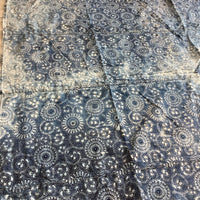
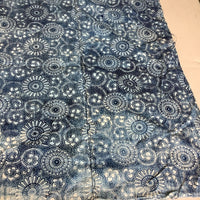
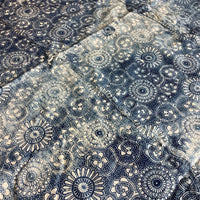
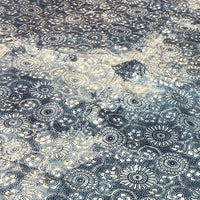

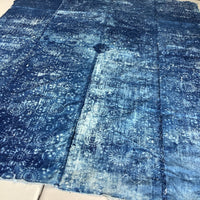
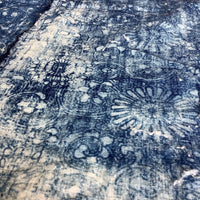

Antique Indigo Futon-ji – Chrysanthemum Medallion & Peony Scrolls, 4 Panels Wide
A richly detailed example of antique Japanese futon-ji, this cloth features large chrysanthemum medallions framed by curling vinework and smaller floral bursts. The design is bold yet balanced, with layered rosettes that recall both chrysanthemum and peony forms—motifs traditionally associated with vitality, longevity, and auspicious beauty. The patterning has a rhythmic flow, the kind of visual cadence that made katazome-dyed futon-ji both decorative and deeply practical in the home.
In Japanese, futon-ji refers to the outer cloth of a traditional futon—futon meaning the bedding, and ji meaning cloth or ground. Before industrial weaving, rural families created futon-ji by stitching together multiple narrow widths of handwoven cotton. Each strip was woven on a small home loom, typically 13.5–14" wide, then joined with hand stitching to form a large, comfortable cover. This piece is constructed from four such panels, their seams still visible and texturally rich.
The cloth is dyed using katazome, a traditional resist-dye technique where rice-flour paste is brushed through hand-cut mulberry stencils. After several dips in natural indigo vats, the paste is rinsed away to reveal crisp motifs against a deep blue ground. The softened edges and slight tonal shifts in this piece often reflect decades of domestic use and repeated washings; however in this instance, it may also be sun fading from prolonged storage where only some parts were exposed. The cloth does not have holes or signs of excessive wear.
This futon-ji carries the character that collectors and makers seek: softened indigo with areas of light fade, subtle wear at old fold points, and surface variations that testify to its history without compromising its structural integrity. It is a beautiful candidate for display, historical study, or reuse in boro-inspired work, quilting, or garment-making.
Age & Attribution
This textile qualifies as antique, likely dating from the Taishō (1912–1926) to early Shōwa period (1926–1940s). We arrive at this estimate through several visual and structural clues:
-
the four-panel construction consistent with early 20th-century domestic weaving,
-
the large-scale chrysanthemum medallion design popular in the late Meiji (1868–1912) and Taishō eras,
-
the oxidation and hue of natural indigo consistent with prewar dyeing,
-
and the style of katazome stencil work typical of rural workshops before mechanized screen-printing became common.
While exact dating requires provenance, these elements consistently point toward an early 20th-century origin. Sharing this reasoning gives you insight into how Japanese textile historians evaluate age through craft characteristics.
Dimensions: 51.25" × 63.75" (130 × 162 cm)
4 panels wide, based on the standard loom width of approximately 13.5–14" per panel before seam allowances.
Made in Japan









